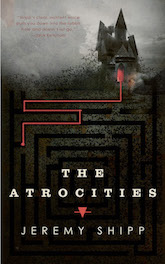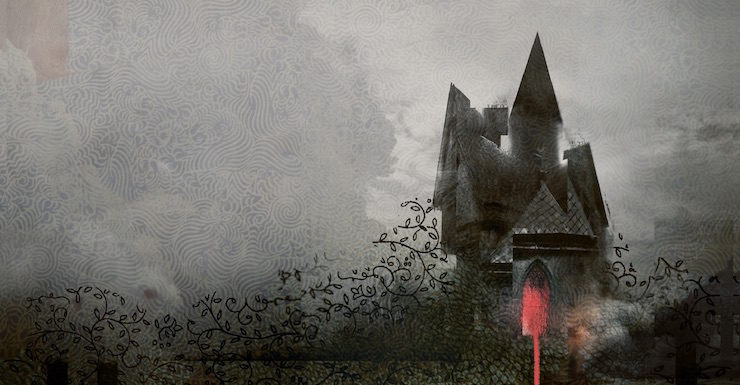If form follows function, as so many designers have attested, then Stockton House, the Gothic manse at the center of Jeremy C. Shipp’s novella The Atrocities, was surely built to be haunted. Let’s consider some of its amenities. On first arriving at the House, the visitor will find herself in a hedge maze; around any corner she may encounter the book’s namesakes Atrocities, the gruesome statues drawn from Biblical stories. They’re a tad unpleasant, but they’re useful signposts for any unlucky visitor who navigating the maze: “Turn left at the screaming woman with the collapsing face” and “turn right at the woman sliced into twelve pieces” are, after all, unusually clear directions. The unusual ornamentation isn’t confined to the grounds: when the new guest arrives, she’ll note that beneath the house’s pyramid spires, “dozens of headless figures populate the yellowing, weatherworn façade.”
Buy the Book


The Atrocities
Should the unwise visitor, in this case a governess brought in to instruct an unruly young girl with special difficulties, enter Stockton House—rather than plunging through the hedges and fleeing in terror—she’ll find the interior just as foreboding. It’s true that there a modern conveniences, like the 84-inch HDTV that dominates the sitting room, but the house has been in the Evers family for quite some time, and some of the former owners remain, ranked in the death mask-bearing funerary owns that line the mantel above the room’s fireplace. And should the visitor retire to their bedroom––down a hallway lined with paintings of ashen angels bearing wings made of human fingers—she’ll find that their bedroom features a large stained-glass window portraying a crowd of “headless figures trekking through a stark landscape.” Anyone would have unpleasant dreams, though the narrating governess’ are, even by nightmare standards, particularly grisly. And in the fresh new morning after the long night, the governess learns that her headstrong and ill-mannered new charge is, in fact, a ghost.
The Atrocities bears a sinister title, a brooding cover, and an enthusiastic blurb from Jack Ketchum, the late master of pitch-dark horror. But doesn’t the plot sound a little comic: a woman charged with teaching a ghost good manners? And isn’t the setting, with its Overlook Hotel hedge maze, its Dario Argento stained glass, and its “Pickman’s Model” paintings, just a little much? Isn’t this house so terrifying as to be ridiculous? As I read on, suspicion arose: could Shipp be writing with his tongue in cheek? After all, what self-respecting haunted house, howsoever brooding its decorations and howsoever dark its corners, would let a frantic capybara wearing a tutu over its hind legs careen down its hallways?
Peter Straub claims that Jeremy Shipp possesses a “willingness to risk damn near everything,” and there’s something to this praise. After all, how many writers would construct the world’s most sinister manse only to let a capybara ride roughshod over it? There’s something admirable about this maneuver, though I can see it frustrating any reader unfortunate enough to believe that a horror story called The Atrocities would offer Thomas Ligotti bleakness or Jack Ketchum dread. But it’s hard to pull off this tonal shift twice, and so it’s less a surprise than it might have been when, in the final ten pages, the story makes a sudden pivot into another genre, and another type of story, entirely.
I read The Atrocities in a single unbroken sitting and came away about equally impressed and perturbed. Shipp’s exaggeration of Gothic clichés, his shifts of tone and plot, his dry humor and his sense of the absurd have all stayed with me, but so have my feelings that should have been a little more to the book. I value concision, but much here seems undeveloped: we learn that the narrator lost her son, for example, and that this loss informs her interactions with the grieving family of the ghost girl in whom she doesn’t quite believe, but the story never arrives at the revelation or catharsis that Shipp seems to be building to. Similarly, one character is introduced in the last few pages to deliver some exposition, then left in jeopardy, albeit promised help. There’s a frustrating abruptness to the ending; just a few additional pages of aftermath and reflection would, to my mind, have improved the book.
Queries and quibbles aside, I truly enjoyed The Atrocities: it’s made me eager to read more of Shipp’s writing, whether archly humorous, bluntly sinister, or, like this book, some strange combination of the two. Stockton House is worth a visit, but do mind the statues, and don’t let the capybara get underfoot.
The Atrocities is available April 17th from Tor.com Publishing.
Read an excerpt from the novella here.
Matt Keeley reads too much and watches too many movies; he is helped in the former by his day job in the publishing industry. You can find him on Twitter at @mattkeeley.










